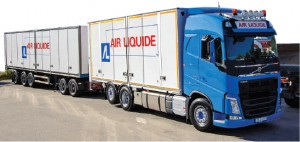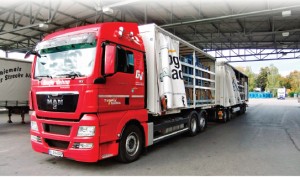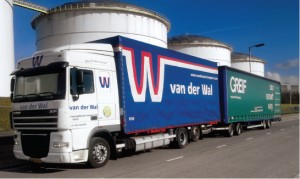Long heavy vehicles, as part of the European Modular System may find more takers.
Story by:
Bhushan Mhapralkar
The European Parliament and the Council of the European Union (EU) brought out a directive (EU) 2015/719 amending the Council Directive 96/53/EC laying down for certain road vehicles circulating within the community. The maximum authorised dimensions in national and international traffic and the maximum authorised weights in international traffic of these vehicles, including the provision for derogations from the maximum authorised weights and dimensions of vehicles and vehicle combinations laid down in Directive 96/53/EC, was amended. Claimed to involve Long Heavy Vehicles (LHVs), the amendment, would enable EU Member States to restrict, for reasons related to road safety or infrastructure characteristics, the circulation of certain vehicles (LHVs) in specific parts of their road network. LHVs in Europe are also referred to as the European Modular Systems (EMS), and trace their roots to the 25: 25 (25, 25 m.) concept that came into being in Scandinavia a little over a decade ago. In Sweden and Finland to be precise. Allowing combinations of existing loading units (modules) into longer and sometime heavier vehicle combinations to be used on some parts of the road network with an intention to improve road transport efficiency and reduce the environmental impact, EMS is finding more takers among the Member States. The Directive may mention about aerodynamic devices, new cab profiles to improve safety by reducing blind spots, alternative powertrains and an extra weight allowance for their heavier powertrains, it is the mention of LHVs, and the EMS therefore, which had drawn the attention of most.
Defined in Directive 96/53 EC, Article 4, § 4 (b), as the Member State which permits transport operations to be carried out in its territory by vehicles or vehicle combinations with dimensions deviating from those laid down in Annex I to be used in such combinations as to achieve at least the loading length authorised in that Member State, so that every operator may benefit from equal condition of competition (modular concept), LHVs appeared in the 1980s for environmental and competitive reasons. Claimed to be a reason for Sweden and Finland to display reluctance in applying EU rules on weights and dimensions, having allowed for long, the operation of longer and heavier vehicles on their roads, the amendment directive by the EU is said to be the result of a compromise reached for allowing longer and heavier trucks with a condition that the existing standardised EU modules were used. Standardised EU modules is nothing but EMS.
Interestingly, when the EMS was first introduced, and found mention in the Directive 96/53, it did not delve upon the 25, 25 m length, nor did it delve upon the 60-tonne weight factor. Those have been the national rules applying to Sweden and Finland only. Each EU Member State thus has been free to allow different combinations of the existing standardised EU modules. A study conducted in Denmark and Germany according to the specifications issued by the European Parliament in 2012, calling for views of stakeholders with emphasis on five EU Member States where LHVs are already permitted or are undergoing trials, concluded that EMS would lead to lower operating costs for road freight. It also concluded that greenhouse gas emission per tonne-km of goods transported will be less as lesser number of vehicles will be needed to transport the same amount of goods. Operating costs would however increase as the heavier vehicles will consume more. On the cautious side, the study highlighted the risk of a modal shift, which could lead to an increase in greenhouses gases. Preference to transport by road could mark a shift away from other modes of transport, thus offsetting any advantages derived by the EMS.
By re-arranging the existing loading units (modules) of trucks into longer and sometimes heavier vehicles – depending on the volume to be transported and roads to be travelled, EMS promises optimised road transport capacity. According to the European Express-Carriers leaflet, the benefits also include satisfying the growing transport demand, reduce fuel consumption as two EMS can substitute three regular road train trucks owing to significant energy savings, lower emissions and lower operator transport costs. Also mentioned in the leaflet is that the EMS Forum supports cross-border use of European Modular Systems between neighbouring and consenting Member States; subsidiarity should be respected, and that the Member States are best placed to decide on transport solutions fit for their road transport network, and that the impact assessments and on-the-road-experience have demonstrated the benefits of EMS and how they can help meet key policy objectives, such as the reduction of emissions and congestion. Apart from the European Express-Carriers, EMS is finding many takers. These include European Shippers Council, EuroCommerce, DTL, TLN, TNT, CLECAT, Michelin, Cepi, Sveriges Akeriforetag, Danske Speditorer, O.T.M, Auft, ACEA, FEBETRA, BWVL, Pacton, Tracon, Eye Octopus b.v., Rockwool, Burg, Anibal Blanco, Imperial Logistics, FNTR, Vos Logistics, van der Wal, Middelbas, G Snel Belgium Group, TLF, European Transport Board, Belgian Courier Association, D-TEC, International Transport Denmark, Ecocombi, Groenewegen, Verhoeven, Flora Holland, VDT, Wabco, High Tech Automotive Systems, IRU, DPD, Transport & Logistiek Vlaanderen, K. Overerest Transport bv, FVG, BIL Sweden, Truck & Milieu, Finnish Transport and Logistics, UniLine, Nordic Logistics Association, and Kuypers Neer among others.
As the number of takers for EMS increases, there are those who are not in favour of such vehicles. They claim that LHVs compromise safety of all road users and damages the environment because they would lead to more truck journeys. They also claim that LHVs will cost taxpayers billions of Euros because Europe’s roads were not designed for such monsters. Citing LHVs as a hindrance to traffic, and difficult to overtake on the road, critics also draw attention to the modal shift EMS may lead up to. With Member States like Netherlands climbing the EMS bandwagon, LHVs, in operation in Sweden and Finland for more than a decade may find more takers. They have already found a number of takers in the two Scandinavian countries. This would not have been the case if the advantages of a LHV would have outweighed the disadvantages. The need is to carefully deliberate upon the nature of EMS that may work in certain parts of Europe better. Over certain roads and regions, and as a part of the hub and spoke transportation structure. Precautions should be taken to ensure that the advantages an EMS can deliver are sustainable and do not lead to a modal shift. Trepidations surrounding the issues of safety and hindrance should be addressed as well. An EMS that is safe and advantageous would make a fit case for takers, and the EU amendment directive looks like a step in the right direction.






















